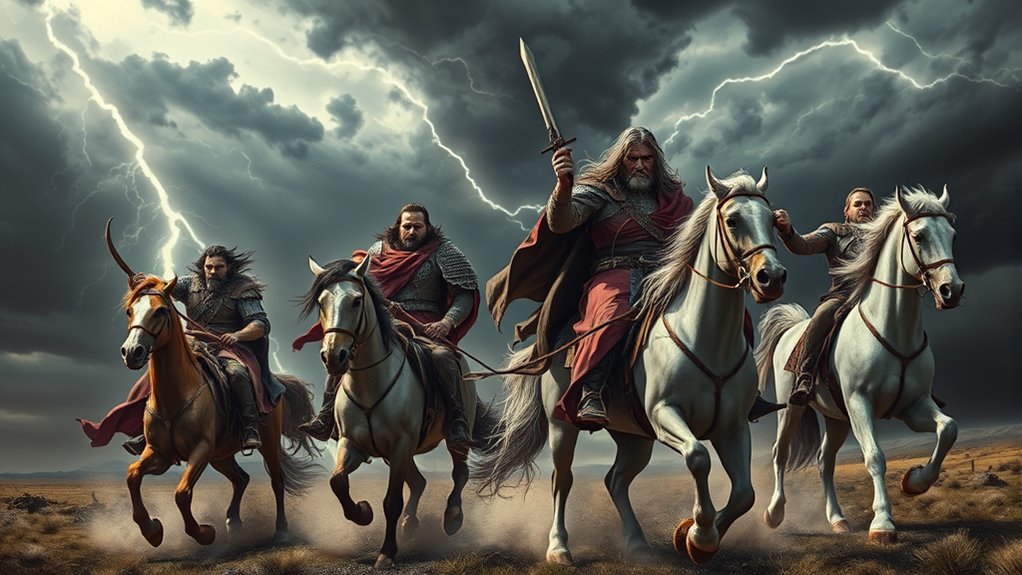The Four Horsemen of Revelation symbolize conquest, war, famine, and death, representing major threats during the apocalyptic end times. They serve as powerful warnings of divine judgment and reflect universal fears about societal collapse, chaos, and humanity’s vulnerabilities. Artists, writers, and modern media often reinterpret these symbols, making them relevant today through images of global struggles. To fully understand their meaning and influence across history, continue exploring their biblical roots and cultural significance.
Key Takeaways
- The Four Horsemen represent conquest, war, famine, and death, symbolizing divine judgment in the biblical Book of Revelation.
- They serve as apocalyptic symbols warning of end times and moral challenges faced by humanity.
- Artistic and cultural depictions interpret their biblical symbolism through visual art, literature, and modern media.
- The Horsemen are used as metaphors for societal issues like conflict, economic hardship, and environmental crises today.
- Their enduring symbolism highlights universal fears and the ongoing relevance of apocalyptic themes across history.
Origins and Biblical References

The origins of the Four Horsemen trace back to the biblical Book of Revelation, where they are introduced as powerful symbols of divine judgment. In biblical prophecy, these figures represent different facets of the end times, embodying chaos and moral testing. Their appearance signals significant moments of apocalyptic symbolism, warning believers of impending divine intervention. The imagery is vivid and loaded with meaning, rooted in ancient texts that aim to convey spiritual truths through symbolic language. As you explore their biblical references, you’ll see how each Horseman reflects a specific aspect of the divine plan—conquest, war, famine, and death—highlighting the profound connection between prophecy and apocalyptic imagery. Their origins serve as a foundation for understanding their enduring significance in religious and cultural contexts.
Symbolism of the Horsemen
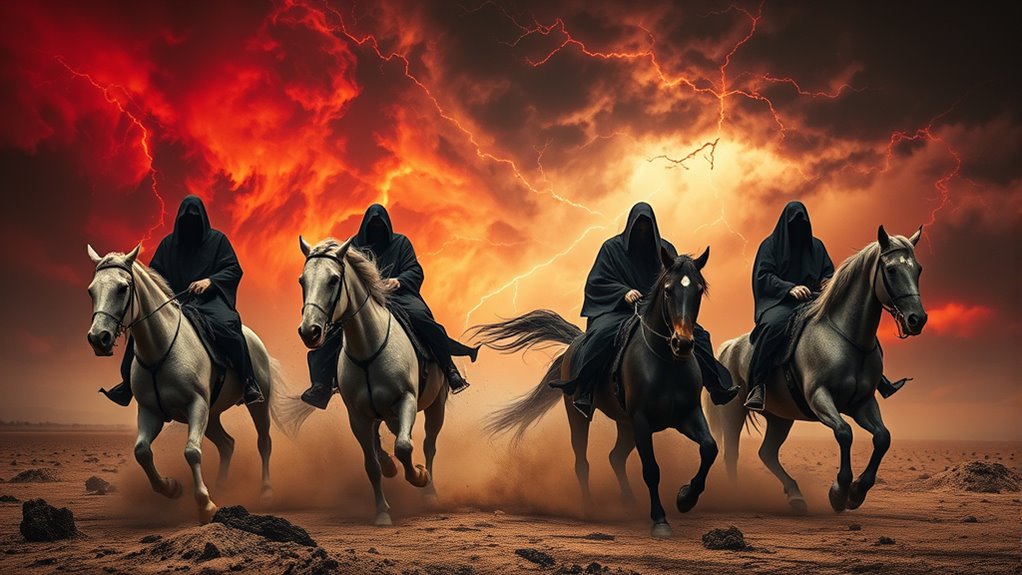
The vivid imagery of the Four Horsemen carries a deep symbolic meaning that extends beyond their biblical origins. Their apocalyptic symbolism represents more than just chaos; it signifies divine judgment and the unfolding of significant world events. When you examine their symbolism, consider these key points:
- The white horse symbolizes conquest and the spread of power.
- The red horse embodies war and bloodshed.
- The black horse reflects famine and economic hardship.
- The pale horse signifies death and the end of life.
Each horseman acts as a warning of divine judgment, illustrating how spiritual forces influence worldly calamities. Their imagery warns of moral decline and impending reckoning, emphasizing the profound symbolic connection between divine justice and human suffering.
Artistic Interpretations Through History
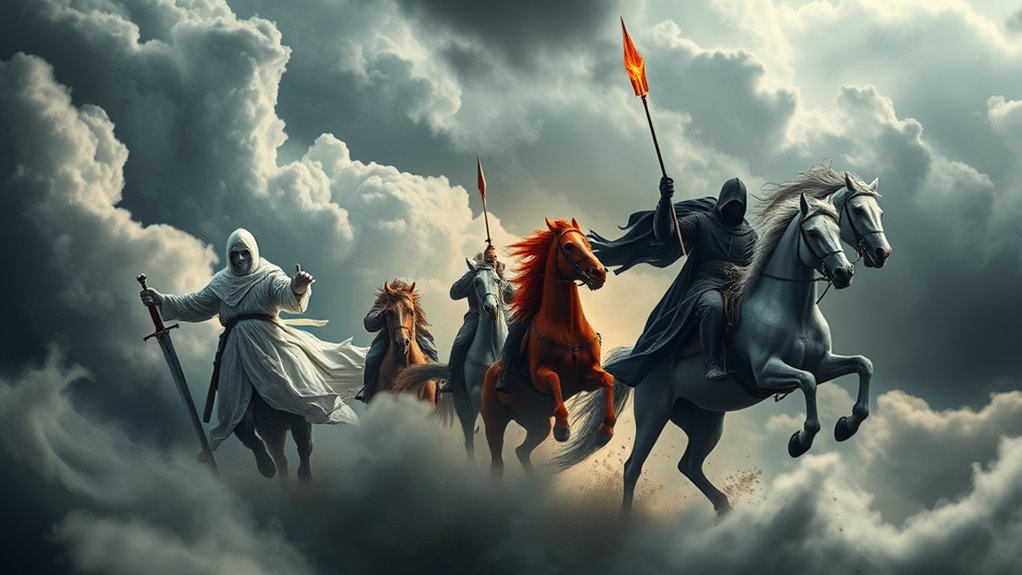
Throughout history, artists have vividly interpreted the Four Horsemen, translating their biblical symbolism into compelling visual narratives. You see how they use prophetic symbolism to depict each rider’s role in the apocalypse, emphasizing themes like conquest, war, famine, and death. These artworks often feature vibrant, dramatic scenes filled with apocalyptic imagery that evoke both fear and reflection. During the Renaissance, painters like Albrecht Dürer and Hieronymus Bosch incorporated detailed symbolism to explore humanity’s vulnerability to divine judgment. In modern times, artists continue to adapt these themes, blending traditional imagery with contemporary concerns about chaos and destruction. Their works serve as visual warnings, capturing the intense, foreboding nature of apocalyptic prophecy while inviting viewers to contemplate humanity’s destiny.
Cultural and Literary Influences
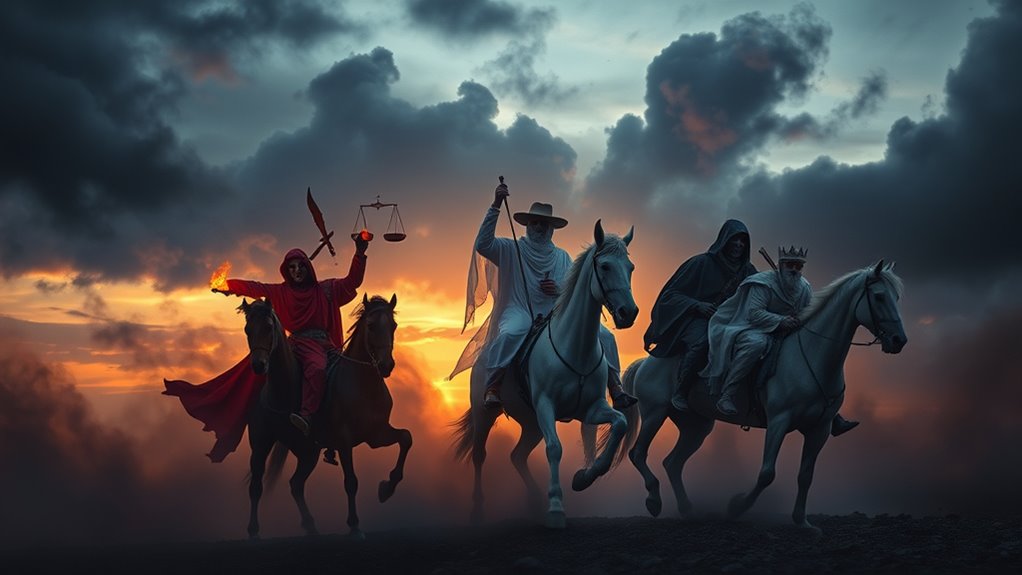
The Four Horsemen have influenced countless stories, art, and symbols across cultures and eras. You’ll see their themes evolve in various artistic depictions, reflecting changing fears and values. Literary allusions often highlight their enduring relevance, shaping how we comprehend chaos and morality today.
Artistic Depictions Evolution
Cultural and literary influences have considerably shaped how artists depict the Four Horsemen of Revelation over time. You’ll notice that symbolic imagery varies based on the historical contexts in which artists worked. To understand this evolution, consider:
- Early medieval art, emphasizing apocalyptic themes and divine judgment.
- Renaissance works, blending biblical symbolism with human emotion.
- Romantic era depictions, highlighting chaos and human suffering.
- Modern interpretations, often reflecting contemporary anxieties like environmental crisis or societal collapse.
Each period’s artistic choices mirror its cultural beliefs and literary influences, transforming the Horsemen’s imagery from abstract symbols to vivid, emotionally charged representations. These shifts demonstrate how art evolves alongside societal values, shaping our visual understanding of these apocalyptic figures.
Literary Allusions and Themes
Literary allusions and themes have profoundly shaped how the Four Horsemen of Revelation are understood and depicted. You’ll notice how apocalyptic symbolism emphasizes chaos, judgment, and the end times, influencing countless works of literature and prophecy. Mythological symbolism also plays a role, connecting these figures to ancient gods and monsters, highlighting universal themes of destruction and renewal. Writers and poets draw on biblical references to deepen the narrative’s impact, often using the Horsemen as allegories for societal fears or moral decay. These literary allusions create a layered understanding, blending religious imagery with cultural fears. By exploring apocalyptic and mythological symbolism, you gain insight into how the Horsemen serve as enduring symbols of inevitable change and cosmic upheaval across diverse literary traditions.
Thematic Connections to End Times
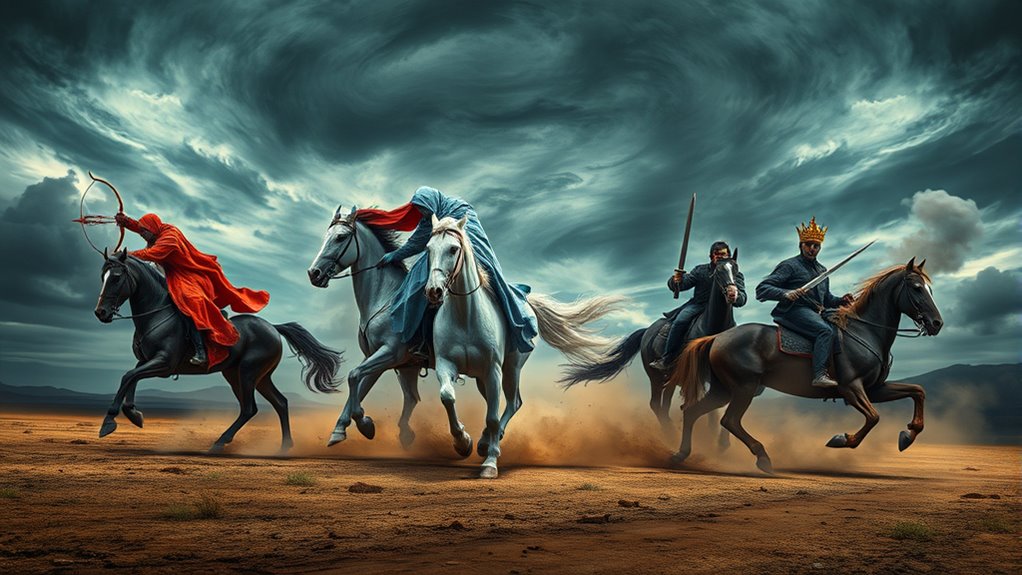
Understanding the thematic connections to end times reveals how the Four Horsemen symbolize universal fears and moral challenges faced during apocalyptic scenarios. Their apocalyptic symbolism and prophetic imagery highlight themes like chaos, judgment, and human vulnerability. Recognizing these themes helps you see how they reflect societal anxieties and ethical dilemmas. Specifically:
The Four Horsemen symbolize universal fears, moral struggles, and societal anxieties in apocalyptic narratives.
- The white horse represents false hope or deception.
- The red horse symbolizes war and violence.
- The black horse signifies famine and scarcity.
- The pale horse embodies death and destruction.
These images serve as warnings, emphasizing the moral struggles humanity faces during crises. By exploring these symbolic elements, you gain insight into the broader messages about morality, survival, and divine judgment embedded in end times narratives.
Modern Depictions and Media Portrayals
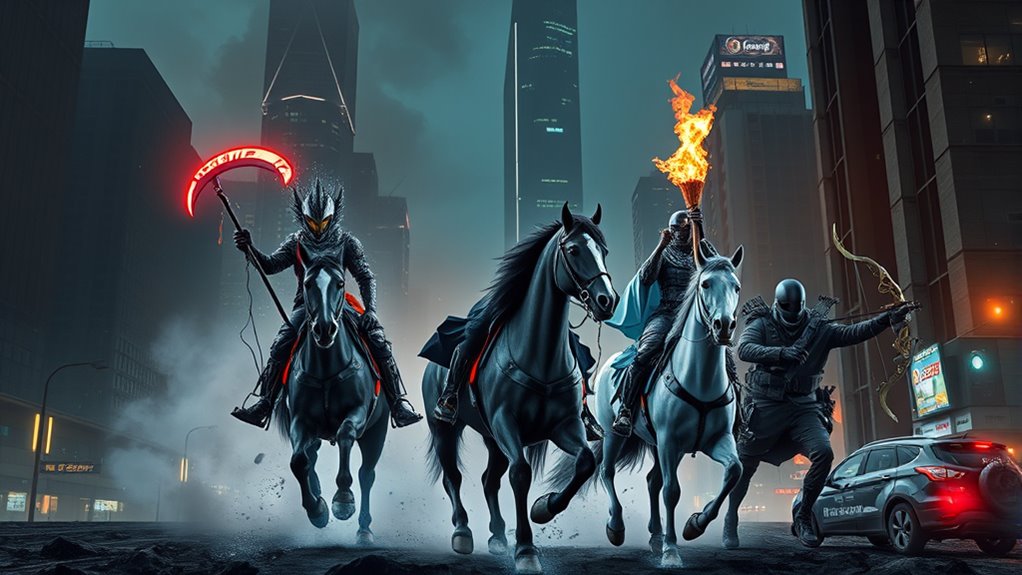
You’ve probably seen the Four Horsemen depicted in films, where they often symbolize chaos and destruction. Writers and artists reinterpret these figures in novels and artwork, giving new meaning to their apocalyptic imagery. Today, cultural references frequently use the Horsemen to comment on current issues, making their symbolism more relevant than ever.
Visual Interpretations in Film
Film and media often bring the apocalyptic imagery of the Four Horsemen to life through striking visual interpretations that resonate with modern audiences. These portrayals emphasize allegorical symbolism, transforming ancient descriptions into compelling images. You might notice how apocalyptic fashion enhances each Horseman’s identity, emphasizing chaos or destruction. Filmmakers often use vivid color palettes, like red for war or black for plague, to symbolize their roles. Here are some key visual elements:
- Dramatic costume design reflecting apocalyptic fashion.
- Symbolic imagery, such as scales or swords, to represent the Horsemen’s traits.
- Use of lighting and color to evoke mood and tension.
- Creative special effects to depict destructive forces convincingly.
These visual choices deepen your understanding of their allegorical meanings while enthralling your attention.
Literary Adaptations and Art
Modern artists and writers reimagine the Four Horsemen through various media, blending ancient symbolism with contemporary themes. In literature and art, they often incorporate vivid apocalyptic imagery to evoke a sense of urgency and chaos. These adaptations use allegorical symbolism to explore modern fears—climate change, political upheaval, and technological collapse—while referencing the original biblical figures. You might see these themes in graphic novels, poetry, or visual art, where the Horsemen serve as powerful metaphors for societal struggles. By reinterpreting their roles, creators highlight timeless human anxieties and moral questions. This approach deepens your understanding of the Horsemen’s relevance, transforming biblical symbols into compelling tools for commentary on today’s world.
Contemporary Cultural References
Contemporary media frequently reimagines the Four Horsemen, portraying them in films, television shows, video games, and digital art to reflect current societal fears. These pop culture references use modern symbolism to explore themes like chaos, disease, war, and economic collapse. You might see them depicted as literal riders or as allegorical figures representing modern issues.
- Films often depict the Horsemen as apocalyptic villains, emphasizing fears of global catastrophe.
- TV series use them to symbolize societal breakdowns or political unrest.
- Video games incorporate their imagery to evoke chaos or moral dilemmas.
- Digital art employs modern symbolism to reinterpret their roles in a world overwhelmed by modern fears.
This creative approach keeps their relevance alive, blending timeless symbolism with current cultural anxieties.
The Horsemen’s Relevance Today
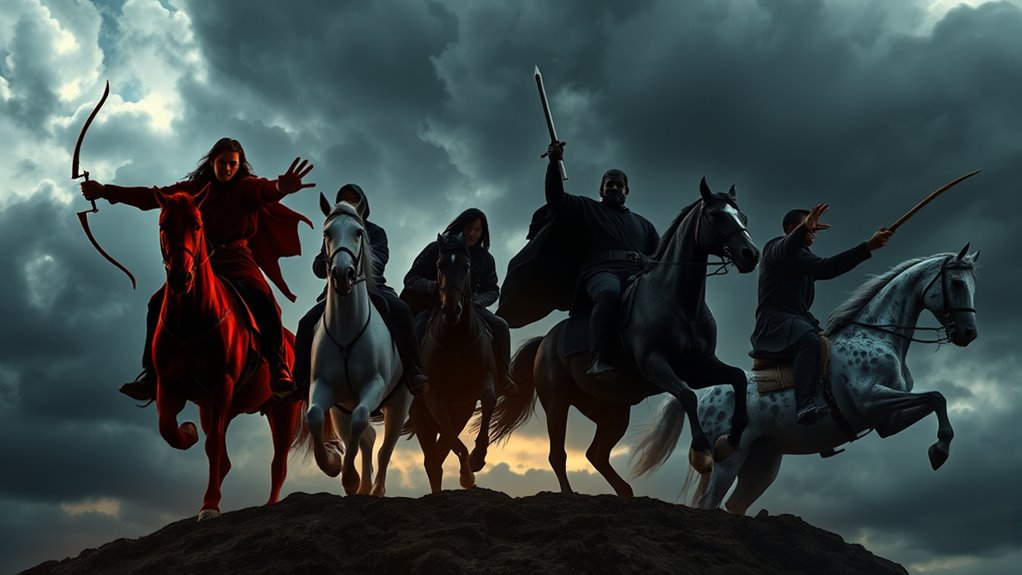
The symbolism of the Four Horsemen remains strikingly relevant today, as their themes echo through current global issues. Their symbolic significance highlights ongoing struggles like war, economic instability, disease, and environmental crises. These themes resonate with modern implications, reminding us that these ancient allegories still reflect our world’s challenges. You can see their influence in contemporary debates about climate change, political unrest, and health pandemics. Recognizing the Horsemen’s symbolism helps you understand the fears and uncertainties shaping society. Their presence underscores the importance of awareness and preparedness. While rooted in biblical prophecy, their relevance persists, serving as a stark reminder that humanity’s vulnerabilities and struggles remain timeless and universal.
Frequently Asked Questions
How Have Different Religions Interpreted the Four Horsemen?
You see, different religions interpret religious symbolism and apocalyptic narratives differently. Some view the Four Horsemen as literal events, warning of divine judgment, while others see them as allegories for moral struggles or societal changes. These interpretations reflect each religion’s teachings and cultural context, shaping how followers understand concepts of end times and morality. Your perspective might emphasize spiritual renewal or caution against chaos, depending on your faith’s teachings.
Are There Any Historical Events Directly Linked to the Horsemen Symbolism?
You might think apocalyptic symbolism is purely myth, but history offers some parallels. Events like the Black Death or World Wars seem to echo the chaos and destruction the Horsemen symbolize, blurring lines between myth and reality. Ironically, these moments of upheaval become modern echoes of ancient fears, showing how historical parallels often mirror the darker themes of apocalyptic visions, even if the Horsemen themselves aren’t directly linked to specific events.
How Do Contemporary Authors Depict the Four Horsemen?
You see contemporary authors often use apocalyptic imagery and literary symbolism to depict catastrophic themes. They portray chaos, disease, war, and famine through vivid, often unsettling descriptions that evoke strong emotional responses. These writers aim to reflect modern anxieties, using symbolism that resonates deeply with readers, emphasizing humanity’s vulnerabilities. Their works serve as cautionary tales, blending timeless symbolism with current issues to create powerful narratives about impending disaster and societal collapse.
What Psychological Themes Are Associated With the Horsemen?
You see, psychological themes like apocalyptic anxiety and moral decay often surface when exploring these symbols. They represent deep fears about societal collapse and personal moral decline. As you explore these ideas, you might notice how they evoke feelings of dread and helplessness, reflecting collective concerns about the future. These themes tap into your subconscious, revealing how humans grapple with uncertainty and the erosion of moral values in turbulent times.
Do the Horsemen Have Any Influence on Modern Political Discourse?
Imagine apocalyptic politics as a storm brewing, with symbolic influence shaping debates and decisions. You see, the idea of four symbolic forces often echoes in modern discourse, fueling fears and highlighting societal struggles. These allegories remind you how fears of chaos and destruction influence political narratives today, making the Horsemen’s symbolism a powerful metaphor for understanding the intense emotions and conflicts that drive current political landscapes.
Conclusion
As you explore the four horsemen of Revelation, you realize they’re not just ancient symbols but powerful forces shaping your understanding of chaos and change. Their story is woven into every corner of art, culture, and media—warning, inspiring, and haunting you all at once. Remember, these horsemen are like the thunderclap of history’s most epic storm, reminding you that the end times are closer than you think—more real than you ever imagined.

